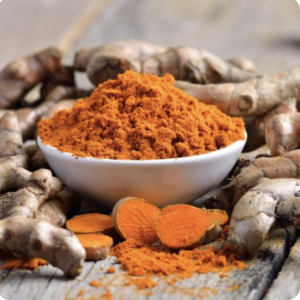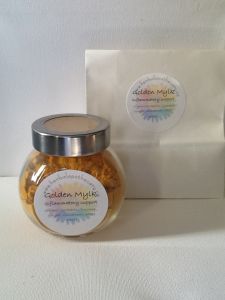_______________________________________________________________________________________________________________________
Turmeric -
The Golden Goddess
Most of us know turmeric as the vibrant orange powder in the spice section of the grocery store. The colour brings forth the rich, warm tastes of Indian cuisine in its distinct and delicious dishes. Turmeric has been a staple of Indian food traditions for millennia and has a long history of healing uses (over 4,000 years) in Traditional Chinese and Ayurvedic medicinal traditions.
Kanchan is its Sanskrit name and means the ‘Golden Goddess’ and is used in Hindu devotional and sacred ceremonies. Traditional Ayurvedic medicine uses turmeric as a healing agent for the gastro-intestinal tract, aches and pains, liver disorders and skin abrasions. Modern research confirms the anti-bacterial, anti-inflammatory and anti-oxidant properties of turmeric.
The part used is the rhizome, which can be consumed dried, cooked or raw and has a slightly peppery, mildly bitter and earthy flavour. The component that gives the golden orange hue is called curcumin and has been isolated by scientists as the main ingredient for turmeric's healing properties.
While turmeric is hailed as a miracle herb it is not for everyone. This is a pungent herb which is somewhat warming and very drying. When taken in larger than normal culinary amounts, there can be side effects such a dry eyes, dry mouth, night sweats.
This drying effect can be balanced in a few ways. Taking turmeric with liquid such as golden milk is one way. As well as lowering the dosage. The bottom line is it is not for everyone. Check with a herbalist or health practitioner If you are not sure.
How to use this excellent herb?
Anti-inflammatory
This herb is a potent anti-inflammatory and is used for many aches and pains, including muscle aches, back pain, cramping, and joint pain. A randomized 2009 study examined turmeric's efficacy, and safety in patients with knee arthritis concluded that turmeric was as effective and as safe as ibuprofen. (Kuptniratsaikul et al., 2009). Again keep in mind that turmeric may be too drying for this condition.
Vulnerary (wound healing) and Anti-bacterial (kills pathogens)
As turmeric has anti-bacterial properties, it can be combined with a little salt and mixed as a paste, or you can make a paste of cooked turmeric and honey to apply to the skin where there are abrasions, swelling, bruising, minor irritations and insect bites.
Turmeric Gargle for a sore throat
*A pinch or two of turmeric
*A pinch or two of salt
Add to warm water and gargle as you would regular salt water.
Choleretic (helps promote bile)
The bitter principle of turmeric lends itself to assisting the digestion by stimulating the production of bile which helps promote digestion. (please check safety recommendations at end of article)
Tumeric can be used as a tincture, powder, capsules or seasoned in your food. If you have the time the traditional method is to cook the root in water for twenty minutes. As turmeric is rapidly metabolizeyd by the liver and intestines, its medicinal properties may not be as effective unless it is consumed with black pepper which has been found to enhance the bioavailability of the curcumin in turmeric by 2000% (Shoba iet al., 1998)
More research is being done to determine if there are any anti-cancer actions, including its ability to inhibit cell growth and metastases. Also studies are underway to determine if turmeric can provide some protection against Alzheimer’s disease. We will wait and see!
Turmeric Recipes
Adding turmeric to your food is a great way to get the benefits in a natural safe way. Traditional instructions for the use of turmeric is to make a turmeric paste first, which can be spread on toast or added to other dishes or you can simply use the powder instead.
Turmeric Paste
¼ cup ground turmeric
½ of cup water
Directions:
*combine turmeric powder and water in a saucepan
*simmer until mixture forms a thick paste
*let cool, store in the fridge
Golden Milk
Golden Milk- Serves one
Ingredients:
*1 cup unsweetened coconut, rice, almond milk or dairy milk
*1/4 to ½ teaspoon turmeric powder or paste
*1 teaspoon coconut oil(optional)
*few shakes of ground black pepper
*generous dash of vanilla
*raw local honey or maple syrup to taste
*sprinkle of cinnamon
Directions:
1. Place 1 cup milk with turmeric, oil, black pepper, vanilla, and honey/maple syrup into a blender
2. Blend on high briefly until combined and foamy
3. Pour into cup, sprinkle with cinnamon and serve
Can be served warm if you wish.
Note: If you wish to make tea simply use one cup of hot water instead of milk to the above recipe without using the blender.
(c) Wendolyn Murdoch
Disclaimer: The information, including but not limited to, text, graphics, images and other material contained on this website are for informational purposes only. It is not intended to be a substitute for professional medical advice, diagnosis or treatment. Always seek the advice of your physician or other qualified health care provider with any questions you may have regarding a medical condition or treatment and before undertaking a new health care regimen.
The owner of these written materials makes no claims as to the accuracy or completeness of any of the information, including any links. The owner will not be liable for any errors or omissions in this information. The owner will not be liable for any losses, injuries, or damages from the use of this information.


